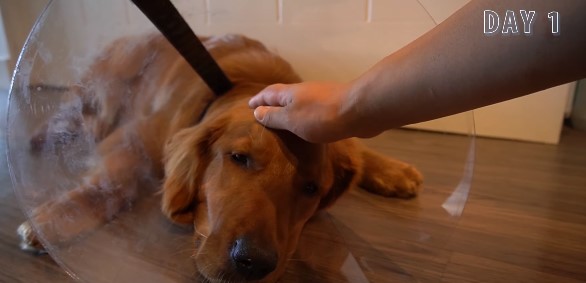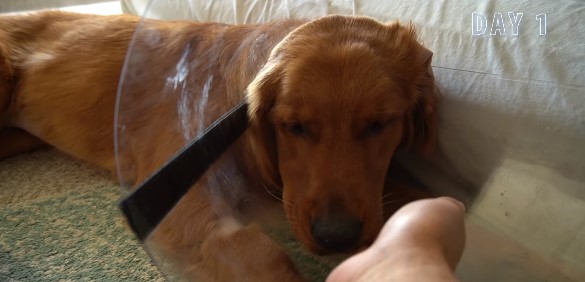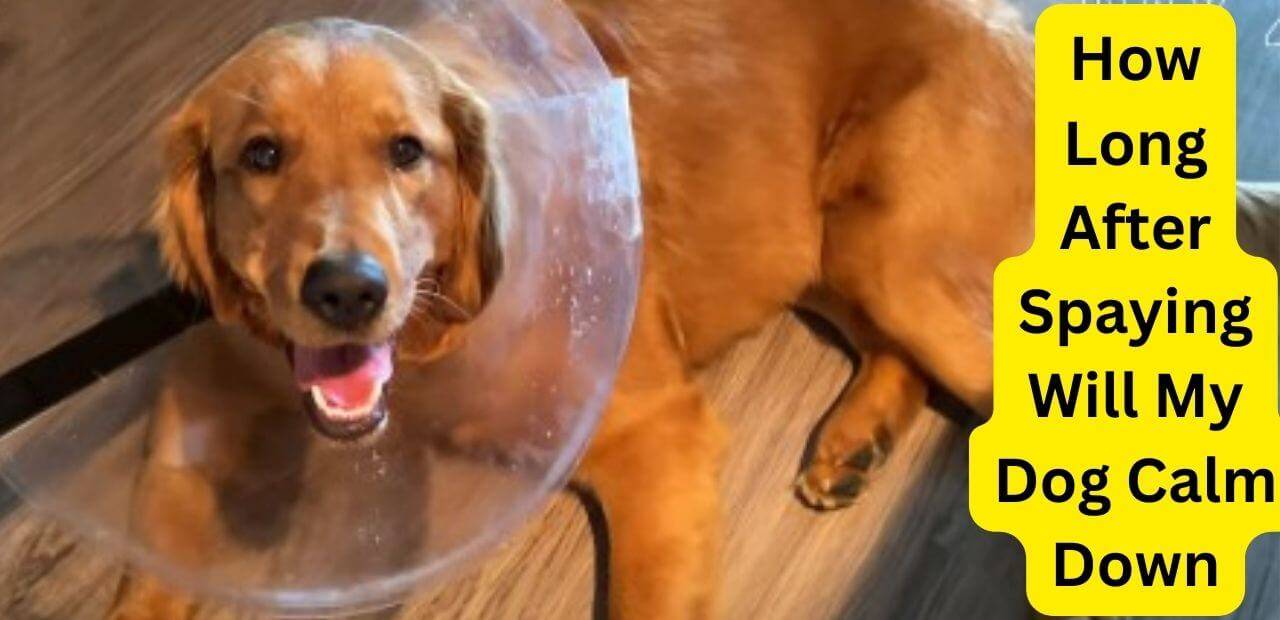If you’ve just had your beloved dog undergo the spaying procedure, you might be wondering when the post-op zoomies will settle down. How long after spaying will my dog calm down? is a common question, and we’re here to fetch you some answers in simple terms.
Bringing home a spayed pup is like welcoming a new, more serene version of your furry friend. We’ll guide you through the typical timeline and what you can expect during this important healing period.
Techniques for Keeping Your Dog Calm after Spaying
After your dog has been spayed, it is important to take certain measures to ensure their post-surgery calmness. Here are some professional techniques on how to keep your dog calm after spaying.
Firstly, provide a quiet and comfortable space for your dog to rest. Create a calm environment free from any excessive noise or disturbances.
Set up a cozy bed or blanket where your dog can relax and recover peacefully. Limit their physical activity and encourage them to rest as much as possible.
Secondly, consider using a calming aid, such as a pheromone diffuser, or natural remedies like lavender oil. These can help reduce anxiety and promote relaxation in your dog. Consult with your veterinarian to decide on the best option for your furry friend.
By following these techniques for keeping your dog calm after spaying, you can aid in their recovery and ensure a smooth transition to their normal routine.
Remember, it is essential to provide a supportive and calm environment to facilitate your dog’s healing process.
Understanding the Timing: When Female Dogs Typically Calm Down
Female dogs typically go through a variety of behavioral changes throughout their lives, and understanding the timing of when they typically calm down can be beneficial for dog owners.
The age at which female dogs calm down can vary depending on factors such as breed, size, and individual temperament.
For example, large dog breeds may take longer to reach a calmer state compared to smaller breeds. On average, most female dogs start to show signs of calming down between the ages of two to four years.
However, it’s important to note that this is a general guideline and individual dogs may calm down sooner or later.
Hormonal changes, such as spaying, can also play a role in the timing of when female dogs calm down. Taking these factors into consideration can help dog owners better understand their dog’s behavior and provide appropriate care and guidance.
How Long After Spaying Will My Dog Calm Down
Around 3 weeks. Hormones staying around in spayed females or dogs’ sex Hormones tend to diminish quickly post-spying.
However, the hormones can take a minimum of around 3 weeks to calm down fully. During this time period her scent might retain the ability to draw in male canines, so don’t be surprised. Some dogs become irritable or nervous and even feel pain due to ovulation.
Because spayed dogs don’t experience these hormonal changes, a female dog’s behavior may be more consistent after she is spayed. Aggression, females may be less aggressive toward both dogs and people after they are spayed.
Behavioral Changes in Female Dogs after Spaying: What to Expect

Behavioral changes in female dogs after spaying are a common concern for many pet owners. While every dog may react differently to the procedure, it is important to understand what to expect.
Spaying, which is the removal of a female dog’s reproductive organs, can have an impact on their behavior.
One key behavioral change is a decrease in certain hormone-related behaviors. Female dogs that have been spayed usually experience a reduction in behaviors such as roaming, urine marking, and attracting male dogs during their heat cycle.
This can be a significant relief for pet owners who are looking to control these behaviors and provide a calmer environment for their dogs.
However, it is important to note that the extent of these behavior changes can vary among individual dogs. Some may see more dramatic changes, while others may not experience much difference at all.
It is essential to closely observe your female dog’s behavior after spaying to better understand how she responds to the procedure and to address any issues that may arise.
Addressing Aggression: Can Spaying Help with Your Dog’s Aggressive Behavior?
When it comes to addressing aggression in female dogs, many pet owners wonder if spaying can help. While spaying is primarily a surgical procedure to prevent reproduction, it can also have some impact on a dog’s behavior.
However, it’s important to note that spaying alone may not be a guaranteed solution for aggressive behavior.
Spaying a female dog can reduce the intensity of some aggressive behaviors, especially those linked to reproductive hormones.
Removing the ovaries and uterus can decrease the production of estrogen, which may help in reducing territorial aggression and dominance-related aggression.
Additionally, spaying may also decrease the likelihood of certain behavior problems influenced by reproductive hormones, such as excessive marking or roaming tendencies.
However, it’s essential to remember that each dog is unique, and other factors, such as genetics, early socialization, and training, can also contribute to aggression.
Therefore, while spaying may play a role in addressing aggression, it is most effective when combined with proper behavioral training and management techniques.
Coping with Restlessness: Tips for Dealing with a Dog That Can’t Stay Calm after Spaying
When a female dog undergoes spaying, it is not uncommon for some dogs to experience restlessness and difficulty staying calm during the recovery period.
This can be challenging for pet owners who want to ensure their furry friends have a smooth and comfortable post-surgery experience.
If you find yourself in a situation where you can’t keep your dog calm after spaying, there are some tips and strategies you can implement to help manage their restlessness.
Firstly, it’s essential to create a calm and quiet environment for your dog. Limit their exposure to loud noises, excessive activity, and any potential sources of excitement.
Providing a comfortable and secure resting area can also help them feel more at ease. Furthermore, ensuring they have access to their favorite toys or chew treats can aid in redirecting their attention and focusing their energy on something positive.
Regular exercise is crucial, but it’s important to find a balance between keeping your dog active and avoiding excessive physical exertion.
By adhering to these tips, you can create an environment that promotes relaxation and minimizes restlessness in your dog after spaying.
Managing Hyperactivity: Will Spaying Make Your Dog Less Hyper?
Spaying your dog can have an impact on their behavior, but it is important to understand that it may not directly result in a decrease in hyperactivity. Some dog owners may wonder, “Will my dog be less hyper after spaying?”
The answer to this question is not as straightforward as a simple “yes” or “no.” While spaying can help reduce certain behaviors associated with heat cycles, such as restlessness and wandering, it may not necessarily address hyperactivity.
It is essential to consider individual factors such as breed, age, and overall temperament when assessing the impact of spaying on your dog’s hyperactivity.
Hyperactivity in dogs can be influenced by various factors, including genetics, environmental stimuli, and individual personality traits. Spaying alone may not be the sole solution for managing hyperactivity in your dog.
However, when combined with other behavioral interventions, such as regular exercise, mental stimulation, and consistent training, spaying can contribute to a more balanced and calmer demeanor over time.
It is crucial to consult with a professional, such as a veterinarian or dog trainer, to discuss the best approach for managing your dog’s hyperactivity after spaying and to create a tailored plan that addresses their specific needs.
Safely Assisting Your Dog: How to Lift and Handle Them after Spaying

After your dog undergoes spaying surgery, it is important to handle them with care and ensure their comfort during the recovery period. One crucial aspect is knowing the proper technique to lift and handle your dog after spaying.
By following these guidelines, you can ensure that your dog feels safe and supported, reducing any potential strain or discomfort.
First and foremost, it is essential to approach your dog calmly and confidently. Gently talk to them using soothing words to help them feel at ease.
To lift your dog safely, start by positioning yourself close to their side, standing with your feet shoulder-width apart. It is important to maintain a strong stance for stability throughout the process.
Place one hand under your dog’s chest, near their front legs, while the other hand wraps around their hindquarters. Lift them smoothly and slowly, ensuring that their entire body is supported.
Avoid grabbing or pulling at their legs or stomach area, as this can cause discomfort.
The Behavioral Effects of Neutering: When and How It Can Change Your Dog’s Behavior
Neutering is a common procedure performed on dogs to prevent reproduction and provide various health benefits. However, it is important to understand that the behavioral effects of neutering can vary from dog to dog.
While some dogs may experience behavior changes shortly after the surgery, others may take longer to show any significant alterations.
The timing of when behavior changes occur after neutering can depend on several factors, including the dog’s age, breed, and individual temperament.
In general, it is believed that behavior changes can start to manifest within a few weeks to a couple of months after the surgery. However, it’s important to note that this is not set in stone, and every dog is unique in how they respond to the procedure.
Some dogs may exhibit immediate behavioral changes, while others may take longer to adapt to the hormonal shifts.
Understanding how long after neutering behavior changes can occur in your dog will help you better manage and address any adjustments that may arise.
Decoding “Spayed”: What It Means for Your Dog’s Reproductive Health
When it comes to understanding what “spayed” means for your dog’s reproductive health, it is important to grasp the concept and its implications. Spaying is a surgical procedure that involves the removal of a female dog’s reproductive organs, including the uterus and ovaries.
This procedure is typically performed to prevent unwanted pregnancies and eliminate the heat cycle, as well as to reduce the risk of certain health issues such as uterine infections and mammary tumors.
By undergoing spaying, your dog will no longer be able to reproduce, ensuring that you will not have to worry about accidental litters or the various challenges associated with managing the heat cycle.
Spaying your dog has several noteworthy impacts on her reproductive health. Firstly, by removing the ovaries, spaying eliminates the production of hormones responsible for the heat cycle, thus preventing her from going into heat.
This means that you will not have to deal with the physical manifestations of heat such as bleeding and the increased likelihood of attracting intact males.
Additionally, spaying significantly reduces the risk of serious conditions like pyometra, a potentially life-threatening uterine infection, and mammary tumors, which are often malignant in unspayed females.
By opting for spaying, you are promoting your dog’s overall reproductive well-being and minimizing the chances of encountering reproductive health issues later on in her life.
Additional Considerations: Tips for a Smooth Recovery After Spaying

Many dog owners have questions and concerns about the recovery process after spaying their dogs. It’s essential to be well-informed and prepared to ensure a smooth and successful recovery for your furry friend. Here are some frequently asked questions and helpful tips to assist you during this time.
One common concern is how long it takes for a dog to recover after spaying. While each dog is different, it typically takes about 10 to 14 days for the incision to heal fully.
During this time, it’s crucial to keep your dog calm and restrict their activity level to allow for proper healing. Avoid strenuous exercise, jumping, or rough play that could potentially disrupt the healing process.
Additionally, prevent your dog from licking or scratching the incision site by using an Elizabethan collar or a specialized recovery suit. These precautions will help prevent infection and promote a smoother recovery overall.
Another question often asked is about pain management during the recovery period. It’s normal for dogs to experience some discomfort after the surgery.
Your veterinarian may prescribe pain medication that you can administer at home to alleviate any pain or discomfort your dog may be experiencing.
Make sure to follow the prescribed dosage and frequency strictly. Additionally, providing a comfortable and quiet space for your dog to rest during the recovery period can help promote relaxation and aid in their overall comfort.
frequently Ask Question

How long does it take for a dog to recover after spaying?
The recovery time can vary, but most dogs require about 14-21 days to fully recover after spaying.
Can I let my dog run and play immediately after spaying?
No, it is important to restrict your dog’s activity for at least a week after spaying to avoid complications and promote healing.
How should I keep my dog calm after spaying?
You can keep your dog calm by providing a quiet and comfortable environment, limiting exercise, using a crate, and providing mental stimulation through toys and puzzles.
Should I be concerned if my dog’s behavior changes after spaying?
It is normal for a dog’s behavior to change slightly after spaying, but if you notice any severe or concerning behavior changes, it is best to consult with your veterinarian.
Will spaying help with my dog’s aggressive behavior?
Spaying may help reduce aggression in some female dogs, but it is not a guaranteed solution. It is always recommended to consult with a professional dog behaviorist for guidance.
How can I cope with my dog’s restlessness after spaying?
You can cope with your dog’s restlessness by providing mental and physical stimulation, engaging in calm activities, and using calming techniques such as massage or aromatherapy.
Will spaying make my hyperactive dog less hyper?
Spaying may help to reduce hyperactivity in some dogs, but individual results may vary. A balanced diet, regular exercise, and training can also contribute to managing your dog’s hyperactivity.
How should I lift and handle my dog after spaying?
It is important to support your dog’s abdomen and hind end when lifting or handling them after spaying. Use a towel or a secure grip to minimize discomfort.
Can neutering change my dog’s behavior?
Neutering can have behavioral effects in male dogs, such as reducing aggression and roaming tendencies. However, the extent of behavior changes may vary among individual dogs.
What does “spayed” mean for my dog’s reproductive health?
“Spayed” refers to the surgical removal of a female dog’s reproductive organs, which eliminates the possibility of pregnancy and helps prevent reproductive-related health issues like uterine infections or cancer.
How can I ensure a smooth recovery for my dog after spaying?
Ensure a smooth recovery by following your veterinarian’s post-operative instructions, providing a comfortable and quiet space for your dog to rest, monitoring for any signs of complications, and contacting your vet if you have any concerns.
Final through
In conclusion, the journey of helping your furry friend calm down after spaying is filled with love, patience, and understanding.
It’s natural to be concerned about when your dog will regain their usual tranquility after the procedure. Remember, every dog is unique, and their recovery timeline can vary.
Spaying is a vital step in ensuring your dog’s health and happiness, but it’s also a big change for them. It might take a few weeks to a couple of months for your pup to settle into a new routine and regain its usual demeanor.
During this time, shower them with extra affection and gentle care. Comfort them when they need it, and be understanding of any changes in behavior.
Patience is key in this process. As you provide a comforting environment and follow your vet’s guidance, your dog will gradually adjust, and their energy levels will stabilize.
- Smelly House Because of Dog? Take These Hygiene Tips - May 20, 2025
- How to Introduce a Dog To a Cats Without Chaos - May 6, 2025
- 4 Best Cavapoo Rescues in the UK 2024 - April 5, 2024








